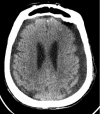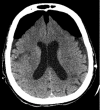What should an intensivist know about pneumocephalus and tension pneumocephalus?
- PMID: 35545242
- PMCID: PMC10265419
- DOI: 10.4266/acc.2021.01102
What should an intensivist know about pneumocephalus and tension pneumocephalus?
Abstract
Collection of air in the cranial cavity is called pneumocephalus. Although simple pneumocephalus is a benign condition, accompanying increased intracranial pressure can produce a life-threatening condition comparable to tension pneumothorax, which is termed tension pneumocephalus. We report a case of tension pneumocephalus after drainage of a cerebrospinal fluid hygroma. The tension pneumocephalus was treated with decompression craniotomy, but the patient later died due to the complications related to critical care. Traumatic brain injury and neurosurgical intervention are the most common causes of pneumocephalus. Pneumocephalus and tension pneumocephalus are neurosurgical emergencies, and anesthetics and intensive care management like the use of nitrous oxide during anesthesia and positive pressure ventilation have important implications in their development and progress. Clinically, patients can present with various nonspecific neurological manifestations that are indistinguishable from a those of a primary neurological condition. If the diagnosis is questionable, patients should be investigated using computed tomography of the brain. Immediate neurosurgical consultation with decompression is the treatment of choice.
Keywords: decompressive craniectomy; nitrous oxide; pneumocephalus; positive-pressure respiration.
Conflict of interest statement
Figures
References
-
- Wolff E. Luftansammlung im rechten seitenventrikel des gehirns (pneumozephalus) Münch Med Wochenschr. 1914;61:899.
-
- Kessler LA, Stern WZ. The ventriculopleural shunt procedure for hydrocephalus: case report of an unusual complication. J Pediatr. 1962;60:418–20. - PubMed
-
- Sweni S, Senthilkumaran S, Balamurugan N, Thirumalaikolundusubramanian P. Tension pneumocephalus: a case report with review of literature. Emerg Radiol. 2013;20:573–8. - PubMed
Publication types
LinkOut - more resources
Full Text Sources



